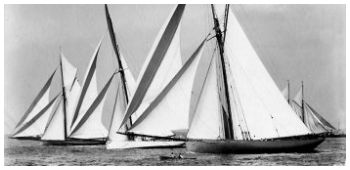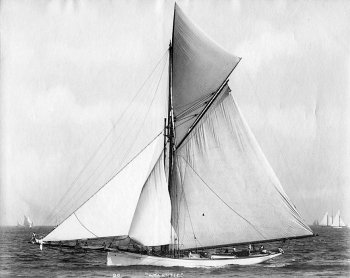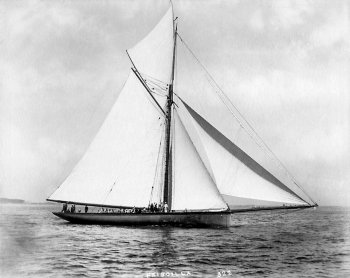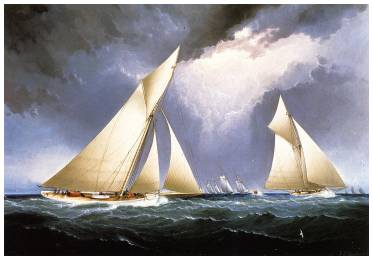Yves GARY Hits: 5967
Category: 1886 : CHALLENGE N°6
 In anticipation of Galatea's coming, Boston yachtsmen immediately “got busy” after the 1885 race, with a view to holding the laurels they had won. General Paine, one of the Puritan syndicate, feeling sure that Puritan could be improved upon, which feeling was shared by the yacht's designer, placed an order with Edward Burgess for a new sloop, somewhat larger than Puritan, of which he was to be the sole owner.
In anticipation of Galatea's coming, Boston yachtsmen immediately “got busy” after the 1885 race, with a view to holding the laurels they had won. General Paine, one of the Puritan syndicate, feeling sure that Puritan could be improved upon, which feeling was shared by the yacht's designer, placed an order with Edward Burgess for a new sloop, somewhat larger than Puritan, of which he was to be the sole owner.
Edward Burgess got to work at once on General Paine's new sloop. She was built at George Lawley's yard at City Point that winter and was launched early in May, being christened Mayflower.
But the New York yachtsmen would not let the “down-easters” get away with the honors without a fight. So a syndicate was formed in the Atlantic Yacht Club, and then located on the Bay Ridge shore, and Captain Philip Ellsworth, a yacht designer and sailor of the old school, was commissioned to draw plans for a big sloop to represent that club.  The outcome of this was the sloop Atlantic, slightly smaller than Mayflower, being 96 feet long over all, and following in general the "compromise" model, having outside ballast through which the centerboard worked.
The outcome of this was the sloop Atlantic, slightly smaller than Mayflower, being 96 feet long over all, and following in general the "compromise" model, having outside ballast through which the centerboard worked.
The New York Yacht Club pinned its faith in this yacht and Priscilla, which had undergone some changes under the direction of Gary Smith, her designer, with a view to lightening her and improving her speed. As a result, there is no doubt that she was a faster boat this year than she was the year before.
Partisanship ran high and there was intense rivalry between the different camps, so that when the Mayflower disappointed her followers by making a poor showing at first, the New Yorkers saw visions of glory returning to the metropolis. The new Boston sloop lost her first three races to the Puritan and it took a vigorous tuning up and many changes in trim before she was “right”. In fact, it was not until the Goelet Cup races early in August that she really came into her own and showed what she could do. On that occasion she beat Puritan nearly six minutes in a forty-mile race and after that did not lose another race during the year.
 The first trial race
The first trial raceThe first trial race took place on Saturday, Aug. 21, 1886, over the New York Yacht Club inside course ; distance, 38 miles. The entries were :
- Puritan centre-board sloop, Boston, racing measurement, 83.85
- Mayflower, centre-board sloop, Boston, racing measurement, 87.99
- Atlantic, centre-board sloop. New York, racing measurement, 86.31
- Priscilla, centre-board sloop. New York, racing measurement, 85.97.
The wind was light from the east-south-east, and when the boats crossed the line the Atlantic held the weather position, with the Puritan on her lee-quarter and the Priscilla a trifle farther to leeward. The Mayflower was some distance astern, but when she crossed was well up to windward. The time of the start was: Atlantic, 10:12:07; Puritan, 10:12:50; Priscilla, 10:13:20; Mayflower, 10:14:26. The Mayflower, 2 minutes 19 seconds in the rear of the Atlantic, began to force the battle at the start. Pointed high in the wind, she went along at a pace which the Puritan could not hold so close to the wind. She gradually closed up on the latter, and in the run to the light-ship passed the two New-Yorkers. The lightship was rounded by the Mayflower at 1:36:40; Atlantic 1:44:40; Puritan 1:46:05; and Priscilla 1:50:10; and they all started homeward with their spinnakers out. The Mayflower continued to widen the gap, and at the finish line led the Atlantic, her nearest competitor, by over a mile.
THE SUMMARY OF THE FIRST RACE:
Course. 38 miles; New York Yacht Club inside course.
Wind. Light ; east-south-east.

The Mayflower won by 10 minutes 50 seconds, corrected time.
The Mayflower allowed the Atlantic 1 minute 1 second ; the Priscilla, 1 minute 12 seconds; the Puritan, 2 minutes 26 seconds.
 The second trial race
The second trial raceOn Monday, August 23, an attempt was made to sail the second trial-race, but after the yachts had sailed ten miles the wind gave out, and a postponement resulted. The Puritan was then in the lead, the Mayflower second, the Priscilla third, and the Atlantic,, which had carried away her top-mast, was out of the race.
The second trial race occurred on Wednesday, August 25, over a course fifteen miles to leeward and return. The wind was north-north-east, and the run was south-south-west, the start being from Sandy Hook Lightship, three miles farther out than the Scotland Lightship. With a steady 20-knot breeze, the race proved to be a grand one. The Mayflower started with a handicap of 2 minutes 25 seconds, but nearly overhauled her rivals before the outer mark was reached. The beat homeward showed that the Mayflower was the superior of the other flyers in strong winds as much as she had been in light winds, and at the finish she led the Puritan by half a mile, and the others by over a mile.
THE SUMMARY OF THE SECOND RACE:
Course. — 30 miles; 15 miles to leeward and return, starting from Sandy Hook Lightship.
Wind. — 20 miles an hour; north-north-east.

The Mayflower won by 3 minutes 47 seconds, corrected time. The Mayflower allowed the Atlantic 48 seconds; the Priscilla, 57 seconds; the Puritan, 1 minute 53 seconds.
The committee immediately selected the Mayflower as the defender of the challenge for the America's Cup.
She was sailed by Capt. " Hank " Haff, a skipper who was to become an international figure in Americas Cup annals and who soon won a place in the hearts of the American public second to no other professional sailor. General Paine, her owner, was also on board in all of her races, with his thorough knowledge of racing and of trim, set of sails, and the many elements that make for speed in a yacht.
